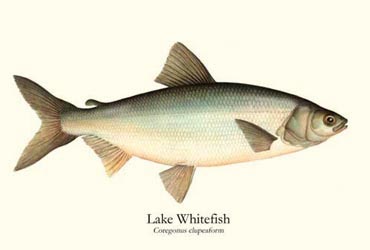Whitefish
Introduction
Whitefish are the most abundant group of fish north of the Alaska Range, inhabiting almost every type of river and freshwater habitat in this section of Alaska. Whitefish are important in the food chain of the aquatic community, but they are not often sought-out by anglers. Whitefish have potential as a sport fish, and a few small commercial fishing operations exist; however, their greatest use in Alaska is as a subsistence food for Natives and their dogs. The sheefish, or inconnu (genus Stenodus), is the largest species of whitefish. The seven smaller whitefish species belong to the genera Prosopium and Coregonus.
Whitefish in general are silver-coloured with large scales, fleshy dorsal and adipose fins, no teeth, and a small fleshy appendage at the base of the pelvic fin (called a pelvic axillary process).
In Alaska the broad whitefish (Coregonus nasus) is found in the Yukon and Kuskokwim river drainages and in the Bering and Chukchi seas and Arctic Ocean drainages. Spawning occurs in the fall with most fish spawning over a gravel bottom. The humpback whitefish (Coregonus oidschian) is distributed throughout all drainages north of the Alaska Range, as well as in the Copper and Susitna rivers, Bristol Bay drainages, and in isolated river systems farther south. The broad whitefish and the humpback whitefish are referred to as true whitefish. In both species the mouth is inferior, an adaptation for bottom feeding. Their diet consists mainly of small clams, snails, aquatic insects, larvae, and freshwater shrimp.
 Humpback whitefish first spawn at 4 or 5 years of age and start their upstream migration during the summer and fall. Spawning occurs in the upper reaches of rivers in October, usually over a gravel bottom. As with other whitefish, the humpback digs no nest but broadcasts its eggs which lodge in the gravel. Growth varies from river to river, though humpback whitefish attain lengths of 22 inches and 5 pounds in eight years. Both the broad and humpback whitefish are important in the subsistence economy of Alaska Natives; they have commercial value as well as providing sport fishing opportunities. Humpback whitefish first spawn at 4 or 5 years of age and start their upstream migration during the summer and fall. Spawning occurs in the upper reaches of rivers in October, usually over a gravel bottom. As with other whitefish, the humpback digs no nest but broadcasts its eggs which lodge in the gravel. Growth varies from river to river, though humpback whitefish attain lengths of 22 inches and 5 pounds in eight years. Both the broad and humpback whitefish are important in the subsistence economy of Alaska Natives; they have commercial value as well as providing sport fishing opportunities.
Lake Whitefish: Found in the Great Lakes, lake whitefish (Coregonus clupeaformis) are a delectable dish. In the 1800's, lake whitefish often reached 20 pounds. Most lived about 10 years, though a few lunkers reached 30 years. Lake whitefish usually feed along the bottom and are generally safe from the sportsman's fishing tackle. But since 1970, commercial fishing nets have annually harvested more than two million pounds from Green Bay and northwestern Lake Michigan.
Whitefish school in cold, deep waters and are still plentiful in Lake Superior and the northern parts of Lakes Michigan and Huron. However, they have disappeared from some areas where they were once abundant.
Round whitefish: round whitefish (Prosopium cylindraceum) have rounded, cigar-like bodies with tiny, pointed snouts and single nasal flaps. The upper jaw extends out over the lower jaw so the mouth is placed lower (inferior). The young have parr marks (dark transverse bands) which disappear in the second year of life. Round whitefish seldom exceed 16 inches in length.
Round whitefish average about two to three pounds and inhabit all the Great Lakes but Lake Erie. Those in shallow waters near the islands and shores of northern Lake Michigan and Lake Huron are known locally as "menominees".
Round whitefish feed at or near the bottom, mainly on small aquatic organisms and eggs of lake trout and other fish. Round whitefish fish are themselves prey for adult lake trout and other large predators, so they are nonetheless valued residents of the northern Lake Michigan-Huron region. Few individuals today approach the four- to six-pound weight of the round whitefish caught in the 1800s. Those who have eaten round whitefish praise their dinner-plate quality, however.
Fishing Techniques
Lake whitefish can be taken almost any time of year, though most fishing is done through the ice. Summer or winter, the usual method is baiting the location with chum (cut-up fish) several days before fishing, then bobbing a light sinker and small hook baited with a piece of cut-up fish near the bottom. During ice out, lake whitefish may be taken with flies at the surface. These fish put up a strong fight and both species are superb table fare.
|